Stay in shape this winter (and beyond) by incorporating some our favourites exercises we use in our programming. Some are conventional lifts, while others are variations on classics. Some will be more strength focused, while others will dial up your heart rate. Either way, start doing them now! Here we go:
1. The landmine clean and press.
An advanced full body movement focusing on power, The landmine clean and press is the perfect exercise to throw into a conditioning circuit given the amount of muscles you are working. The added rotational component makes this a go to of ours.
Once you’ve got the flow of the movement, it is actually much easier than it looks. Break it down by practising the following on the landmine attachment:
- Single arm high pull.
- .The pivoting of your feet by 90 degrees while changing the bar between your hands.
- A single arm press.
Note: A landmine exercise refers to an angled barbell movement where one end of the barbell is on the ground (either in an attachment such as above or safely wedged into a corner of a wall/something stable).
2. The forward to reverse lunge
With added volume compared to a traditional lunge, this variation targets the quads and glutes from two different angles, and really ups your heart rate! You don’t need to add much weight to feel this lunge variation in all it’s glory. Try to go from the forward direction to reverse without your foot touching the ground in between for balance. Regarding technique, practice the following:
- On the forward lunge, keep your spine in a straight line perpendicular with the ground.
- On the reverse lunge, hinge/tilt forward at the hips more while maintaining a straight back.
- Aim for at least 6 reps on each side (forward to reverse = 1 rep).
3. The trap bar deadlift
If you’ve been following us for a while you’ll know we love deadlifting and we will always recommend the movement, but in this case we are going to recommend the trap bar variation over the barbell for a number of reasons.
Both the barbell and trap bar deadlift help to increase hip mobility and increase strength through the posterior chain (lower and upper back, glutes, hamstring muscles), however the trap bar has less of a load on your spine due the torso being more upright. It could be a good starting point if you lack control and stability through your lower back. The neutral grip positioning of your hands (palms facing towards your body) are also much easier in terms of shoulder stability.
4. Pull Ups
Executing a pull up from a full hanging position is one of the toughest upper body exercises you can do, and requires plenty of strength through your upper back muscles, shoulders, and biceps.
Brace the glutes, keep the core tight, and envision pulling the bar towards your chest. As fitness expert and strength coach Bret Contreas says, think of the pull up/chin up as a moving plank and keep a straight line from the shoulders to the knees throughout the movement. Vary your grips and hand spacing to help improve your performance.
Also, your lats (upper back muscles which run from your shoulders to your hips) are one of the primary muscles being used in a pull up, and are key muscles of your core so strengthening them can assist in improving your squat and deadlift.
5. Goblet Squats
A much more natural squat position in comparison to a front and back squat, the goblet squat should be the starting point for all weighted squats as it allows you to set a rigid spine and perfect the balance and movement of a squat. As well as a starting point, there are benefits to programming variations of the goblet squats for people of all levels.
The goblet squat will help you improve the upright torso position that is needed for more advanced exercises (such as cleans, front and back barbell squats, amongst others), as well as being a great exercise for the quads, core, and upper back. Due to the upright torso position, this also allows for less stress through your lower back.
James
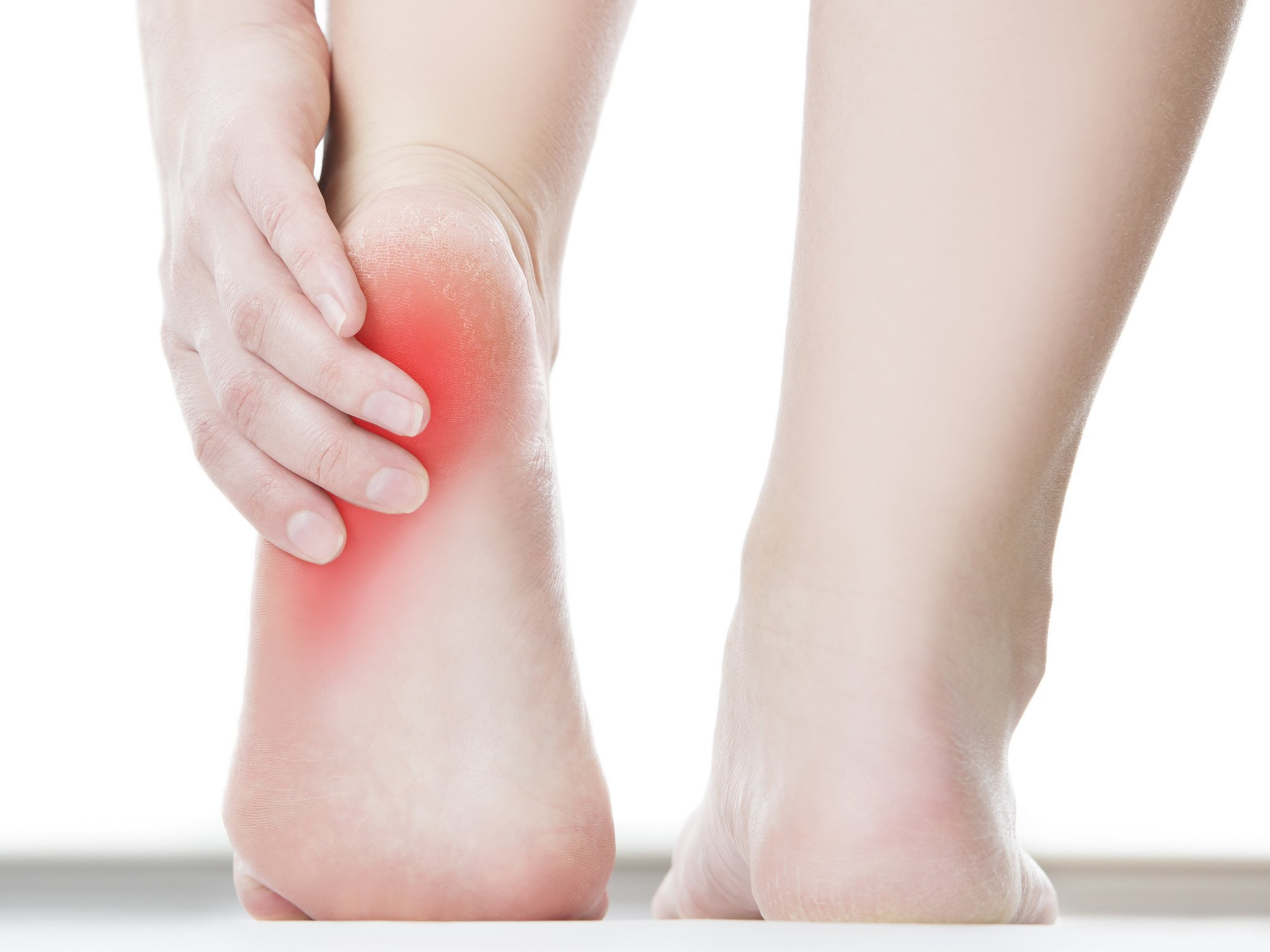
Hello again to the readers of the JS-PT Blog. I felt very honoured to be asked to write another article for you, this time delving into the all too common complaint of plantar fasciitis related heel pain (also referred to as fasciopathy, or fasciosis). In my 6+ years as a practising Podiatrist, I can confidently say that pain under the heel can be a very common issue with a number of possible causes, making it quite handy to have a professional on your side when it comes to treatment. With that in mind, this article, although not exhaustive, will hopefully give you a brief insight into this complex condition and provide some general information regarding treatment. Also, don’t forget to check out our video on the JS-PT Instagram on two quick ways you can directly mobilise the plantar fascia by way of massage and fascia release.
What is plantar fasciitis?
Plantar fasciitis is generally considered to be an overuse condition affecting the strong band of connective tissue (called the plantar fascia) that runs from the front of the heel to the ball of the foot. The role of the plantar fascia is to help to provide support when we’re up on our feet. Normally, the fascia is able to its job without any dramas however in some cases, overstretching and micro-trauma can occur, resulting in pain. This pain is often described by my patients as a sharp pain in the heel after rest (such as getting out of bed or after sitting/lying down), which then gradually dissipates as they “warm up”.
At this point, I think it is important to note that more than one diagnosis is possible for pain around the heel making adequate assessment from a health professional key.
How is it caused?
As plantar fasciitis is an overuse injury, it can theoretically be caused by anything that places excessive strain on the plantar fascia. As a result, common risk factors seen in practise are as follows (this list is not exhaustive):
- Increased BMI (body mass index)
- Poor foot and lower limb mechanics (such as having flat or high-arched feet)
- Wearing unsuitable footwear
- Occupation-related stresses (e.g. excessive periods of sitting or standing)
- Muscle tightness or imbalances
- Pregnancy
In addition, the onset of pain may correlate to a lifestyle change, such as new shoes or the alteration of a training program and exercise levels.
Can this affect the rest of my body?
You bet it can! As a lot of you would know, foot pain is incredibly frustrating as it affects us with every step. Our body, being the intuitive machine that it is, will try and avoid this pain by way of limping or altering its posture to reduce load from a particular structure (you may see where I’m going with this).
Prolonged foot pain can lead to compensatory action from other areas, changing your lower limb mechanics and possibly causing secondary pain in your ankles, shins, knees, hips, or lower back. It can also work the other way around. The cause of your heel pain can sometimes be due to something occurring higher up such as core and/or glute weakness, or misalignment of the lower leg – it’s a two-way street!
What about treatment?
There are a number of different treatment strategies available for plantar fasciitis. For example, some of the conservative treatment techniques available include:
- Rest and icing to manage symptoms
- Specially prescribed stretches
- Mobilisation and massage from a suitably qualified health professional
- At home self-treatments
- Strengthening exercises
- Certain strapping/taping techniques
This list is not exhaustive and some of the techniques above may be more suitable than others depending on the underlying cause. As a result, I would really like to emphasise that plantar fasciitis and heel pain can be complex in nature, with a variety of factors involved in its onset. This is why making an appointment with a Podiatrist is highly recommended as a more in-depth biomechanical assessment can be performed. This not only ensures that the correct diagnosis is made, but a suitable individualised treatment plan may be devised. Moreover, some people require additional support through an orthotic device to help improve function of the foot and lower leg.
For your health and wellbeing:
Remember, a person’s health and circumstances are unique. This information is general in nature and is not intended to replace individual professional advice or the opinion of your medical practitioner. Always seek the advice of a qualified health professional before making any decisions about your health.
Reference:
Brukner, P., & Khan, K. (2012). Clinical Sports Medicine (4th ed.). McGraw-Hill Professional Publishing.
Special thanks to Matt McKean and InStep Podiatry for the special guest blog. For specialist podiatry appointments, find them here.
For more information on training with the team at JS-PT, email us at info@js-pt.com.au.
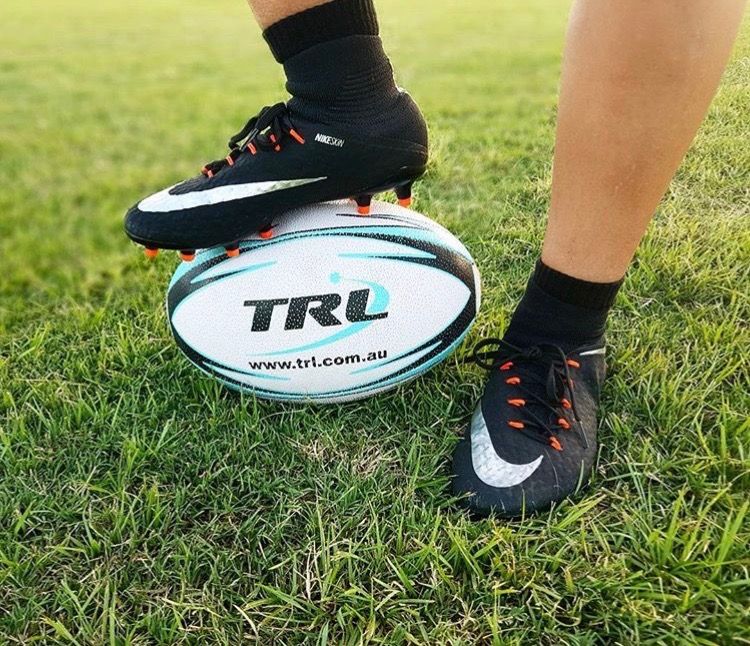 Whilst strength training sets the foundation for fitness, doing so in a gym or with a personal trainer is not the only physical activity you should do to stay healthy, but rather should be part of a wider active lifestyle. Making physical activity an easy part of your daily routine – like cycling on your commute to and from work, for example – or taking it up as a social activity – like weekend hikes or playing a social sport – should also be considered as part of this active lifestyle.
Whilst strength training sets the foundation for fitness, doing so in a gym or with a personal trainer is not the only physical activity you should do to stay healthy, but rather should be part of a wider active lifestyle. Making physical activity an easy part of your daily routine – like cycling on your commute to and from work, for example – or taking it up as a social activity – like weekend hikes or playing a social sport – should also be considered as part of this active lifestyle.
When it comes to social sport, combining fitness with socialising with friends or work colleagues has its benefits both physically and mentally. Social sport gives your training schedule variety and also promotes social health by spending time with friends and meeting new people.
On a personal note, I have been playing Touch Rugby League (TRL) for a number of years as my social sporting competition of choice. More recently, I’ve started working more closely with TRL through JS-PT on corporate health programs as an addition to group training sessions.
To speak more about the benefits of playing social sport and playing TRL in particular, we invited Chairman of TRL Tom Longworth to feature in this month’s JS-PT news:
Touch Rugby League (TRL) was founded in 2005 and has always been a social-sport at heart. Whilst we do offer very competitive and elite pathways, at the heart of our offering is providing teams the chance to exercise and get fit, but in a social context. TRL provides a great opportunity for people to meet others and has been an avenue through which thousands of Corporate teams have built upon team spirit and camaraderie.
Whilst physical health is important, so is mental health and a big part of that is maintaining healthy relationships with friends, family and work colleagues. In reality, we all spend more time with work colleagues than just about anyone so being able to relate to one another in a work context, and to have a strong bond (built on trust and respect) plays a key role in mental health.
TRL provides a great opportunity for people to engage, to develop a sense of trust, respect and teamwork on the field all whilst having fun and of course keeping fit. Strong relationships make for a better workplace.
With multiple locations across Brisbane (and Australia), it has always been straight forward finding competitions to enter, and also has helped me implement more cardiovascular training into my week! For more information on any of the above, please feel free to contact Tom directly by emailing tom@trl.com.au or by visiting the website.
Until next time,
James
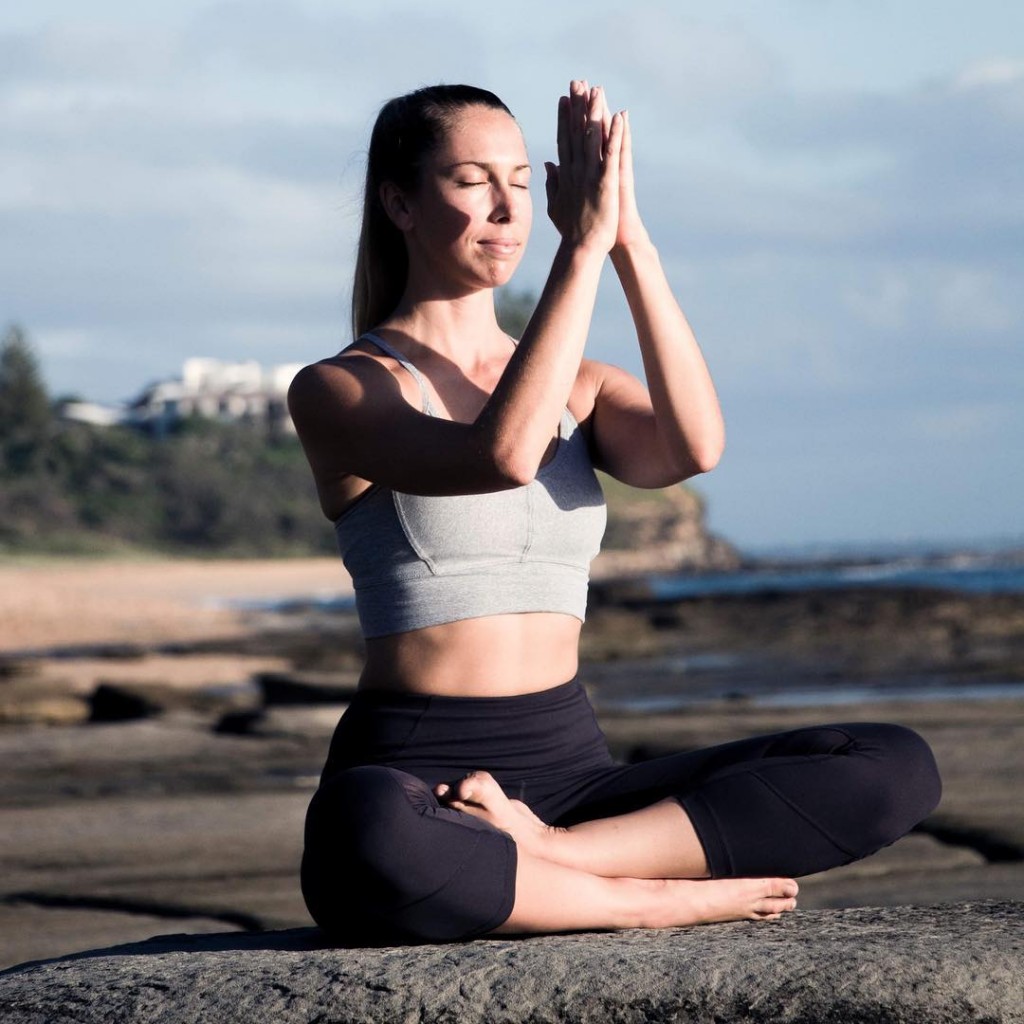
Are you working long hours and often hunched over a computer? Are you racing to and from back-to-back meetings whilst trying not to think about how you will manage the mass amount of emails coming in? Are you feeling stressed and rundown by the increasing demand on employees? As a fellow corporate professional I truly understand how close to home these are working in the corporate world. I have seen firsthand how gradually these detrimental work habits begin to take a toll on our bodies and minds in the form of stress, tension and sickness. Whilst a mild amount of stress can help us meet deadlines, too much or constant stress can have a significant impact on our overall wellbeing. We spend over one-third of our life at work, that’s why it’s so important that we introduce tools early to help us better handle workplace stress and improve our overall wellbeing in the corporate world.
One of these great tools I have found is Yoga. I’m sure you’ve heard of Yoga, but you may be wondering how turning yourself into a pretzel is going to help you in the workplace? Fair question, so let’s break this down.
Why Yoga?
Everyone has different triggers and reactions to stress and in today’s world, stress is inescapable. The good news is you can develop ways to handle stress through Yoga principles. Numerous studies have shown how Yoga can help to counterbalance the body’s physical, mental and emotional reactions to stress. Yoga is more than merely a physical practice and another element of yoga that is becoming increasingly common in the western world is meditation. Yoga not only assists in the daily pressures placed on the physical body, it can also positively affect your mental and emotional wellbeing through meditation and mindful practices.
You don’t have to be an advanced yogi to learn and apply these tools, so let’s have a look at three quick practices you can implement to better handle stress and improve your overall wellbeing in the workplace.
Desk Yoga
It’s not news that we’re all spending more time hunched over our desks creating tight hips and shoulders, a creaky neck and sore back. All the usual consequences of slouching at your desk for 8 hours a day. Sitting for prolonged periods of time can lead to imbalances in your body that cause poor posture and injury down the road. Yoga can help reduce discomfort and target areas of tension, being an effective way to counterbalance common physical ailments.
I’ve suggested 6 quick and effective stretches you can do at your desk in less than 5 minutes. If you need a visual, google these names for the image of the stretch:
• Seated neck stretch
• Wrist stretch and release
• Seated chair twist
• Desk shoulder opener
• Chair hip opener
• Standing forward fold
Taking some time in your workday to perform these quick stretches might just save you a more expensive trip to the physio!
Mindful breaks
In a world where busyness can be perceived as success, taking a lunch break can sometimes be frowned upon. However, what you do in your lunch break can have a huge impact on your productivity for the rest of the day.
Eating at your desk or spending your break aimlessly scrolling through social media can leave you feeling not very refreshed. Productivity reduces, it’s harder to focus and you may need that extra dose of caffeine to get you through.
So maybe step away from your desk and try a few of these:
• Take a walk around the block without looking at your phone. Really notice what’s going on around you and take in the fresh air.
• Eat your lunch mindfully. Take some time to appreciate the flavor and texture rather than rushing to eat while checking social media.
• Practice some mindful meditation in your break, deep breathing and paying attention to how you’re feeling.
Taking a deliberate break from work with a short walk or a bit of mindful relaxation can have powerful effects on our end-of-day concentration, stress, and fatigue.
Meditation
Research on meditation has shown it has many benefits, such as easing stress and anxiety and inducing feelings of tranquility and calmness. While the body needs constant movement to be healthy, the mind thrives with regular doses of stillness.
Our minds like to be busy to help us accomplish tasks, however this can also cause us stress and lack of focus. The good news is, we can train our minds to be calmer and more focused through the practice of meditation. Spending just 5 minutes in meditation can completely change the way you approach life and how your body responds to stress.
More popularly of late, the western world has been referring to ‘Mindfulness Meditation’. Here’s some quick tools as to how you can implement a 5-minute mindfulness meditation in your day. So set an alarm, and let’s get started.
• Find a comfortable position and close your eyes
• Feel which parts of your body connect to the floor
• Draw your attention to your natural breath, becoming aware of the sensation of each inhale and exhale
• Inevitably, your mind may wander, if it does, draw your attention back to the breath
• Notice the sounds around you
• Notice the temperature of the air on your skin
• If your mind gets carried away in thought, return your focus again to the breath
• When you’re 5 minutes concludes, gently open your eyes and notice what’s around you; colours, objects, people
• Pause for a moment and notice how you feel before continuing your day
There you have it, that’s it! Simple, quick and effective.
The practice involves training your mind to focus and be in the present moment without drifting into concerns about the past or future, which is where stress and anxiety can arise. Like any exercise, consistency is key. Give it a try next time you are standing in line, before a meeting, or anytime you need to regroup and have a moment of downtime. With regular practice, mindfulness meditation may also assist you in:
• Remaining calm under pressure
• Improving focus, attention and productivity
• Making decisions from a calm and grounded place
• Re-energise and clear your mind
• Experience less stress and anxiety
• A sense of connection
• Improved sleep
I hope you enjoy these tips on how you can easily implement yogic principles into your corporate day to better handle stress and improve your overall wellbeing. Like everything, start small and be kind to yourself, but most importantly, make a commitment to yourself as changes don’t happen overnight.
Sending calming vibes your way.
Diane Jeays
From Corporate Yogini (@coporate.yogini on Instagram)
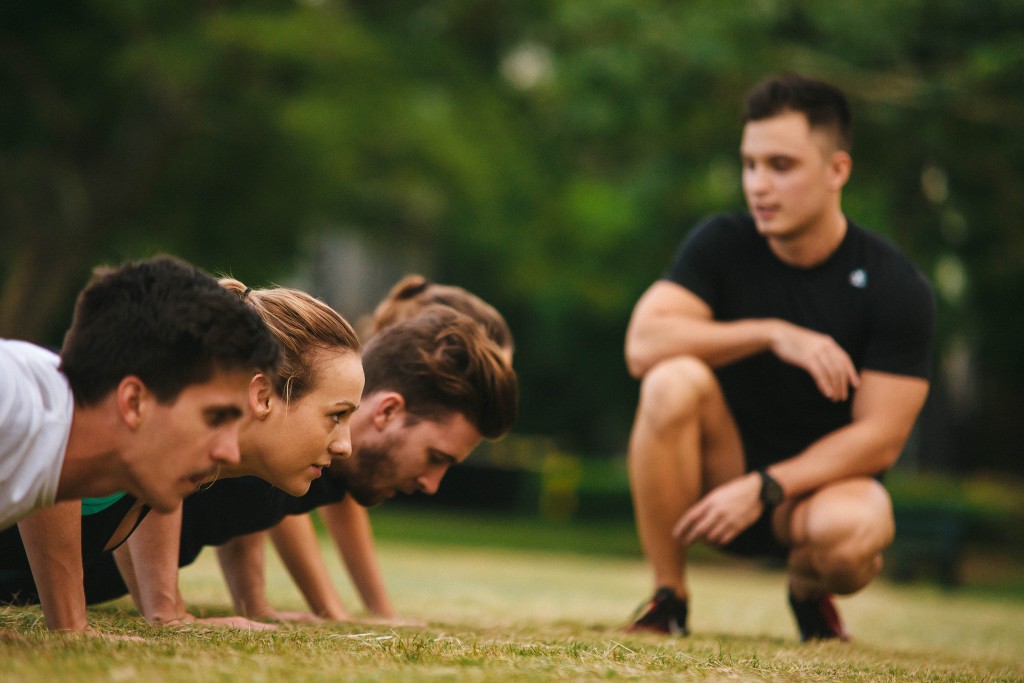
2018 is now in full swing – school holidays are officially over, the Australia Day long weekend has passed and everyone is now full steam ahead into the working year. Welcome back to a more consistent routine! With that in mind, now is the time to establish some healthy habits to get you moving towards your health and fitness goals fast. Whilst the following this isn’t rocket science, being on top of these few steps will ensure you are moving forward efficiently. Here are 5 habits to master to transform your body.
1. Moving more outside of your gym sessions
Whilst everyone’s new year goal tends to be to go to the gym more, or to eat better, when it comes to getting back in shape, something that’s often overlooked, but that is so simple to do, is to just move more in general. Aiming for 30-60 minutes of activity each day in addition to your gym or boot camp sessions ensures you are more active more often. This goal is especially beneficial for people who sit down at a desk all day. Options to move more could include going for a walk when you wake up or during your lunch break, parking further away, or simply just taking the stairs. Walking also aids in your recovery and digestion. Taking up a social sport or activity to mix things up with your normal gym routine is beneficial too given you can catch up with friends while being active.
2. Sleeping 7-9 hours per night
Sleeping more is one of the most overlooked aspects of fat loss, muscle gain and improved performance. Your body recovers primarily when sleeping, so getting some shut eye for 7-9 hours each night will give the body time to rebuild the torn muscle tissues which occur during training and ensure you are recovered adequately for whichever physical activities you may do the following day. Lack of sleep causes a drop in certain hormones (leptin) which play a key role in how ‘full’ you feel, making you more likely to consume more calories through snacking and cravings. Remember, quality counts, so limit the phone and Netflix before bedtime!
3. Controlling your portion sizes
Whilst we’ve recommended the approximate counting of calories through apps such as ‘My Fitness Pal’ in the past (which we still maintain is a useful tool to educate people on the macronutrient and calorie breakdown of different foods), calorie counting can be flawed due to the inaccuracy of food labels and the potential negative and obsessive effect it can have on your eating behaviours. So, with that in mind, try measuring portion sizes using the palm of your hand as a simple and flexible guide – this idea stems from our friends at Precision Nutrition. Aim for 80-90% of your diet coming from whole foods, with the remaining 10-20% spent on whatever you like, assuming you are eating adequate amounts of protein.
4. Increasing water intake and limiting liquid calories
Maybe you’ve read that increased water intake assists with fat loss, but it is not water per se that achieves this, but rather the effect that it may have on your drinking habits, in particular, by replacing ‘liquid calories’ you may have – such as juices, soft drinks or alcohol – with water intake. Drinking enough water per day (2-3L per day) has major health benefits. Studies have shown adequate water intake assists in the transfer of nutrients throughout the body, flushes out toxins, lubricates your joints and digestive tract, and regulates your body temperature through sweating. One particular study which was conducted a few years back showed that drinking 500ml of water increases your energy expenditure (calories burnt) by 24% (1). With this in mind, drink plenty of water before exercise and before meals as this is likely to increase your metabolism for the following hour and make you feel more full before eating.
5. Being mindful of recovery and managing stress
Being mindful of recovery is often something that is overlooked when people increase their activity levels. Above we mentioned the importance of sleep for recovery, but don’t forget that stretches and foam rolling maintains and improves your flexibility and mobility (recovery) too. Yoga is an obvious option here given you focus on not only stretching, but also the calmness of your mind through controlled breathing. Yoga also helps you mix up your exercise routine – lower intensity activities such as yoga, walking, pilates and meditation, combined with higher intensity exercises such as resistance training, conditioning and cardio provides a good mix of endorphin releasing and mindfulness exercises. Another very simple technique to help deal with stress is spending time in nature. Whether that is just by eating lunch in a park, or adding more greenery to your household or office, nature helps lower your stress hormones and heart rate, and improves your mood.
References
1. Boschmann M, Steiniger J, Franke G, Birkenfeld AL, Luft FC, Jordan J. Water drinking induces thermogenesis through osmosensitive mechanisms. J Clin Endocrinol Metab. 2007 Aug;92(8):3334-7.
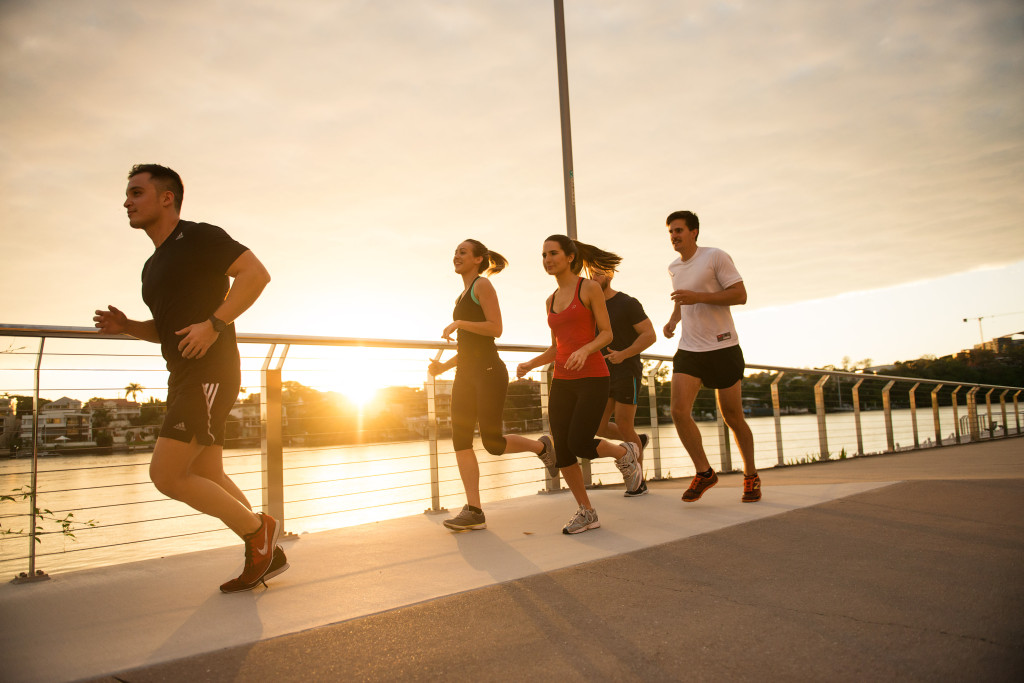 “Increasingly common, yet poorly understood. Felt intensely by the sufferer, yet often invisible to the outside world.”
“Increasingly common, yet poorly understood. Felt intensely by the sufferer, yet often invisible to the outside world.”
The above is a direct quote from an article I read recently by a former sufferer of depression, and considering an estimated 3 million Australians are living with depression and anxiety, chances are someone you know may be experiencing these feelings without you realising. There is no one proven way to help people recover from depression and anxiety, however there are a range of effective treatments, one of which is exercise.
Exercise is so much more to the human body than how you look. The profound effects of how physical activity improves your mental state should not be forgotten.
How exercise helps:
1. You are probably aware that exercise helps boost endorphins in the body, which are neurotransmitter chemicals in the brain which help diminish pain while triggering positive thoughts; this is often that feeling you have after you finish exercising. Exercise may also boost other neurotransmitter chemicals such as serotonin, which is responsible for regulating mood and some cognitive function, and is a chemical that is sometimes low in depressed people.
2.Stress has been linked to depression and anxiety, and exercise is very much considered an antidote to stress. Exercise encourages you to move more, which is immediately forcing your brain to concentrate on the physical tasks at hand, and is then followed by the release of endorphins which will trigger positive thoughts. Consistent exercise also has positive effects on your quality of sleep, something which lacks in someone suffering from depression or anxiety. Studies have shown (including this one with over 110,000 participants) that sedentary behaviour increases your risk of suffering from depression, so try to move and move often.
3. Your self esteem takes a real battering when you’re depressed, so doing something which improves you mentally as well as physically will increase your self esteem and self worth. A healthy body is first and foremost one which feels great mentally.
As was mentioned earlier, there is no one proven way to help people recover from depression and anxiety, however with the proven effects exercise has on the human body such as supporting neurotransmitters and relieving stress, consistent exercise on any level should be strongly considered as a mainstay in your lifestyle if you are suffering from the lows depression and anxiety bring.
While exercise is a very effective form of treatment in dealing with depression, sometimes people need more. If you are feeling as though you need to talk to someone, immediate support is available at Beyond Blue on 1300 22 4636, Lifeline Australia on 13 11 14, and plenty of other organisations which are listed here.
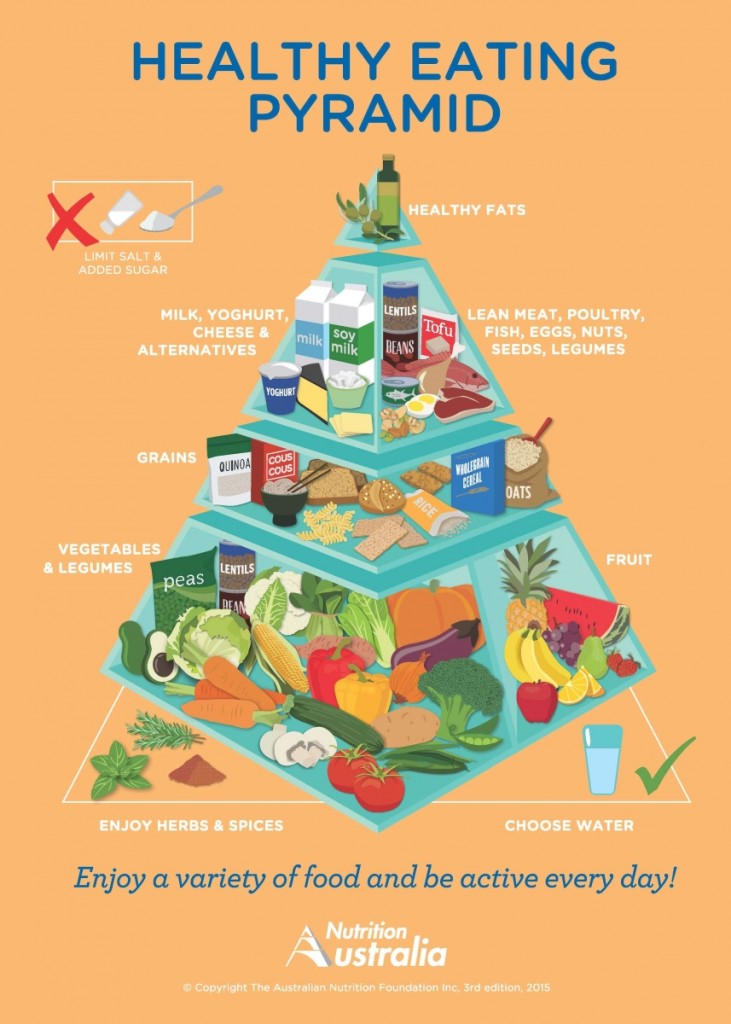
Making sense of what exactly is good and bad nutrition is a tough gig for most people. You could bet your bottom dollar that for every piece of information you find on what you should do, there will be a counter argument somewhere as to why you shouldn’t do it. Thankfully, Nutrition Australia finally released it’s new and revised food pyramid last month which aims to clear things up. Let’s take a closer look:
1. Vegetables take centre stage
The bottom layer of the food pyramid is now predominantly vegetables as well as legumes and fruit. With the high amounts of vitamins and minerals present in these foods, they have been linked to a reduced risk of a number of serious diseases such as cancer, heart disease, and type 2 diabetes.. Vegetables and fruit are also high in fibre which helps with weight control. Given an estimated (and shocking) 7% of Australians reach the recommended daily intake of vegetables, this is a good start to the new pyramid.
On a side note, while both are good options, still aim to eat more vegetables than fruit.
2. Include healthy grains
The renamed carbohydrates group has shifted up from the bottom of the pyramid to put more emphasis on Australians eating more vegetables. Carbohydrates, even with their bad reputation these days, are essential in a healthy diet and the new pyramid encourages (whole)grains such as quinoa, brown rice, multigrain breads, and oats which are also all rich in fibre. That being said, other carbohydrate options such as white rice are not poor options and can easily be included in a well balanced diet.
3. Have a mix of different sources of protein
The second top layer emphasises consuming a variety of protein sources from dairy, meat, and non meat products. While red and white meats are the obvious choices of protein, people often forget dairy products (such as cottage cheese and greek yoghurt; whey protein powder also falls in this category) are also rich in protein as well as being high in calcium.
Consuming a mixture of fish, nuts, and seeds will not only give you variety in your protein, but will also help you reach your recommended intake of healthy fats.
4. Fat is good
Fats are often neglected but they have major roles in the body which include manufacturing and balancing hormones and improving brain and nervous system health. A mix of monounsaturated and polyunsaturated fats are ideal for optimal health. They can be found in oils, avocados, nuts and seeds, fish, and eggs.
5. Junk food has been canned
The previous food pyramids had junk food at the top in the ‘eat in small amounts’ category, and whilst I think the amended food pyramid is much better, I will say that eating a small percentage (under 10% of your daily intake) on whatever you wish will not have an effect on your overall body composition and will also help you control cravings. For the average person though, not having the junk food option on the pyramid is the correct stance.
All in all, Nutrition Australia has done well with the updated version of the food pyramid. For the average person, it is a good starting point to refer to and if followed consistently would definitely improve the current eating habits of Australians unfamiliar with good nutrition practices. Putting more emphasis on vegetable intake is a much needed addition to the pyramid, and is definitely one aspect of nutrition which is hard to disagree on, regardless of what your good and bad nutrition stance is.

Because of my profession, when I’m partaking in activities that aren’t considered “healthy” such as having a few drinks or eating certain types of food, I’m occasionally questioned from someone. As it happened this week when I was overheard talking about having a few beers early Saturday morning for the Socceroos game, I thought I’d make this point:
Health goes beyond food and exercising. A good social life, building and maintaining quality relationships and a positive mental attitude are also vital cogs in the machine that is optimal health. So if you miss your home cooked meal sometimes to instead be with friends or family to go out, don’t worry about it.
Eating all types of foods from chicken breast to ice cream, or consuming alcohol in moderation is fine as well if your overall nutrient needs are being met. “Clean eating” isn’t something that needs to be done 24/7 to be considered healthy.
I will go out for drinks with friends and I will eat what I want, when I want, but I know myself that I meet my nutritional and exercise needs none the less. Be smart, be flexible, and be a good friend/partner and you can enjoy foods which are often vilified without it affecting your health, as well as maintaining and building the relationships that matter to you.







